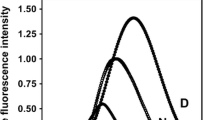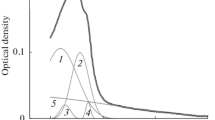Abstract
The temperature dependence of fluorescence anisotropy, lifetime and differential tangent of 1,6-diphenyl-1,3,5-hexatriene (DPH) and its polar trimethylammonium derivative (TMA-DPH) were investigated in cytoplasmic membranes ofBacillus subtilis. The fluorescence parameters were compared in the two types of membranes prepared from bacteria cultivated at 20 and 40°C. Steady-state anisotropy measurements showed that within a broad range of temperatures, membranes cultivated at 20°C exhibit significantly lower values than those prepared from cells cultivated at 40°C. The temperature dependence of lifetime and differential tangent measurements (differential polarized phase fluorimetry) were fully consistent with steady-state anisotropy data of both DPH and TMA-DPH. The low anisotropy values in the case of TMA-DPH could be explained by a shorter lifetime and higher temperature-induced decrease as compared with DPH. Surprisingly, the temperature dependence of rotational rateR calculated according to the model of hindered rotations (Lakowicz 1983) gave misleading results. When increasing the temperature from 5 to 25°C, a marked drop of rotational relaxation rate was observed. The minimumR values were measured between 25 and 30°C and further increase of temperature (up to 60°C) was reflected as increase of theR values. Therefore, a new model of “heterogeneous rotations” was developed. This model assumes that even at low temperatures (approaching 0°C) where the differential tangent reaches zero, a fraction of fast rotating molecules exists. The ratio between fast and slowly rotating molecules may be expressed by this model, the newly calculated rotational rates are fully consistent with anisotropy, lifetime and differential tangent measurements and represent the monotonically increasing function of temperature.
Similar content being viewed by others
References
Bohin J.P., Bohin A., Schaeffer P.: Increased nitrate reductase activity as a sign of membrane alternation in early blocked asporogenous mutants ofBacillus subtilis.Biochimie 58, 99–108 (1976).
Butterworth P.H.V., Bloch K.: Comparative aspects of fatty acid synthesis inBacillus subtilis andEscherichia coli.Eur. J. Biochem. 12, 496–501 (1970).
Cossins A.R.: Adaptation of biological membranes to temperature. The effect of temperature acclimation of goldfish upon the viscosity of synaptosomal membranes.Biochim. Biophys. Acta 470, 395–411 (1976).
Cossins A.R., Sinensky M.: Adaptation of membranes to temperature, pressure and exogenous lipids, pp. 1–20 inPhysiology of Membrane Fluidity, Vol. II (M. Shinitzki, Ed.). CRC Press, Boca Raton (Florida) 1984.
Faucon J.F., Lakowicz J.R.: Anisotropy decay of diphenylhexatriene in mellitin-phospholipid complexes by multifrequency phase-modulation fluorometry.Arch. Biochem. Biophys. 252, 245–258 (1987).
Finne G., Matches J.R.: Spin-labelling studies on the lipids of psychrophilic, psychrotropic and mesophilic bacteria.J. Bacteriol. 125, 211–219 (1976).
Genz A., Holzwarth R.K.: Dynamic fluorescence measurements on the main phase transition of dipalmitoylphosphatidylcholine vesicles.Eur. Biophys. J. 13, 323–330 (1986).
Lakowicz J.R., Prendergast F.G.: Quantitation of hindered rotations of diphenylhexatriene in lipid bilayers by differential polarized phase fluorometry.Science 200, 1399–1401 (1978a).
Lakowicz J.R., Prendergast F.G.: Detection of hindered rotations of 1,6-diphenyl-1,3,5-hexatriene in lipid bilayers by differential phase fluorometry.Biophys. J. 24, 213–226 (1978b).
Lakowicz J.R., Prendergast F.G., Hogen D.: Differential polarized phase fluorometric investigation of diphenylhexatriene in lipid bilayers. Quantitation of hindered depolarizing rotations.Biochemistry 18, 508–519 (1979a).
Lakowicz J.R., Prendergast F.G., Hogen D.: Fluorescence anisotropy measurements under oxygen quenching conditions as a method to quantify the depolarizing rotations of fluorophores. Application to diphenylhexatriene in isotropic solvents and in lipid bilayers.Biochemistry 18, 520–527 (1979b).
Lakowicz J.R.:Principles of Fluorescence Spectroscopy, pp. 156–188. Plenum Press, New York 1983.
Lakowicz J.R., Cherek H., Maliwal B.P.: Time-resolved fluorescence anisotropies of diphenylhexatriene and perylene in solvents and lipid bilayers obtained from multifrequency phase-modulation fluorometry.Biochemistry 24, 376–383 (1985).
Lentz B., Barenholz Y., Thompson T.E.: Fluorescence depolarization studies of phase transition and fluidity in phospholipid bilayers. 1. Single component phosphatidylcholine liposomes.Biochemistry 15, 4521–4528 (1976a).
Lentz B., Barenholz Y., Thompson T.E.: Fluorescence depolarization studies of phase transition and fluidity in phospholipid bilayers. 2. Two-component phosphatidylcholine liposomes.Biochemistry 15, 4529–4536 (1976b).
McElhaney R.N.: The biological significance of alternations in fatty acid composition of microbial membrane lipids in response to changes in environmental temperature, pp. 255–281 inExtreme Environments: Mechanism of Microbial Adaptation (Heinrich M.R., Ed.). Academic Press, New York 1976.
Melchior D.L.: Lipid phase transitions and regulation of membrane fluidity in procaryotes, pp. 263–316 inMicrobial Membrane Lipid: Current Topics in Membrane and Transport, Vol. 17 (Razin S., Rottem S., Eds). Academic Press, New York 1983.
De Mendoza D., Cronnan J.E.: Thermal regulation of membrane lipid fluidity in bacteria.Trends Biochem. Sci. 8, 49–52 (1983).
Prendergast F.G., Haugland R.P., Callahan P.J.: 1-(4-trimethyl-aminophenyl)-6-phenylhexa-1,3,5-triene synthesis, fluorescence properties and use as fluorescence probe of lipid bilayers.Biochemistry 20, 7333–7338 (1981).
Ray P.H., White D.C., Brock T.D.: Effect of temperature on the fatty acid composition ofThermus aquaticus.J. Bacteriol. 106, 25–30 (1971).
Russel N.J.: Mechanism of thermal adaptation in bacteria: Blueprints for survival.Trends Biochem. Sci. 9, 108–112 (1984).
Shintzky M., Barenholz Y.: Dynamics of the hydrocarbon layer in liposomes of lecitin and sphingomyelin containing diethylphosphate.J. Biol. Chem. 249, 2652–2658 (1974).
Shinitzky M., Barenholz Y.: Fluidity parameters of lipid regions determined by fluorescence polarization.Biochim. Biophys. Acta 515, 367–394 (1978).
Shinitzky M.: Membrane fluidity and cellular functions, pp. 1–51 inMembrane Fluidty, Vol. I (M. Shinitzki, Ed.). CRC Press, Boca Raton (Florida) 1984.
Sinensky M.: Homeoviscous adaptation— a homeostatic process that regulates the viscosity of membrane lipids inEscherichia coli.Proc. Nat. Acad. Sci. USA 71, 522–525 (1974).
Svobodová J., Svoboda P.: Cytoplasmic membrane fluidity measurements on intact living cells ofBacillus subtilis by fluorescence anisotropy of 1,6-diphenyl-1,3,5-hexatriene.Folia Microbiol. 33, 1–9 (1988a).
Svobodová J., Svoboda P.: Membrane fluidity inBacillus subtilis. Physical change and biological adaptation.Folia Microbiol. 33, 161–169 (1988b).
Svobodová J., Julák J., Pilař J., Svoboda P.: Membrane fluidity inBacillus subtilis. Validity of the principle of homeoviscous adaptation.Folia Microbiol. 33, 170–177 (1988c).
Thompson G.A.: Mechanism of homeoviscous adaptation in membranes, pp. 33–42. inCellular Aclimatization to Environmental Change (A.P. Cossins, P. Sheterline, Eds). CRC Press, Boca Raton (Florida) 1983.
Wakayma N., Oshima T.: Membrane properties of extreme thermophile. I. Detection of the phase transition and its dependence on growth temperature.J. Biochem. 83, 1687–1692 (1979).
Weber G.: Theory of differential phase fluorometry—detection of anisotropic molecular rotations.J. Chem. Phys. 66, 4081–4091 (1977).
Yang L.L., Haug A.: Structure of membrane lipids and physico-biochemical properties of the plasma membrane fromThermoplasma acidophilum, adapted to growth at 37°C.Biochim. Biophys. Acta 573, 308–320 (1976).
Author information
Authors and Affiliations
Rights and permissions
About this article
Cite this article
Konopásek, I., Svobodova, J., Toptygin, D.D. et al. Rotational relaxation rate of 1,6-diphenyl-1,3,5-hexatriene in cytoplasmic membranes ofBacillus subtilis. A new model of heterogeneous rotations. Folia Microbiol 35, 371–383 (1990). https://doi.org/10.1007/BF02821406
Received:
Issue Date:
DOI: https://doi.org/10.1007/BF02821406




